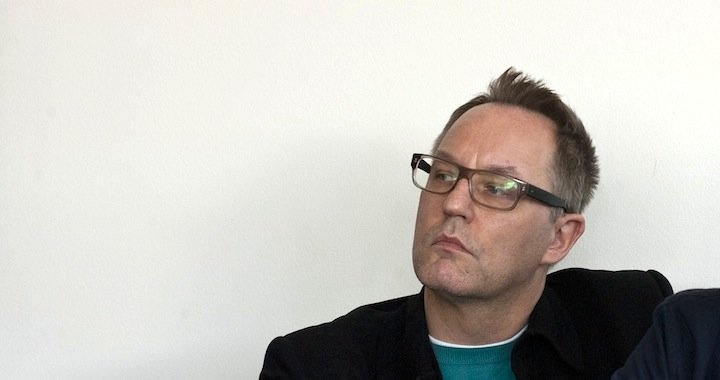
The Contemporary Romantic
An interview with Adam Budak, curator for Estonia's national pavilion at the 55th Venice Biennale
26/03/2013
The relationship between Estonia and the Polish-born, citizen-of-the-world curator, Adam Budak, started a while ago. Namely, a couple of years ago, when the Estonian photographer, Marge Monko, invited Budak to curate the international photography exhibition, “Beyond”, at the KUMU museum (2011). That was also when Budak first met Dénes Farkas, and saw his works. Contacts formed and developed, and this year will see Farkas representing Estonia at the 55th Venice Biennale, with Budak curating the exposition. “It feels surreal,” begins Budak at the press conference for the pavilion's exhibition, “Evident in Advance”, which is being held in the sun-filled cafe of the KUMU museum. Although the nationality of this world-class art professional is rarely even mentioned anymore, one can understand why Budak feels this way. Born in Krakow, and having now come to Tallinn from the US, he sits in front of a panel of Estonian journalists and is about to describe how he will put together their national exhibition. Farkas feels a bit surreal himself, having decided to give up art a couple of years ago (which you can read about in the interview below), but now being actively sought out by well-known professionals. The international team is quite impressive: architect Markus Miessen (London, Berlin), whose studio is building the private library of Hans-Ulrich Obrist in the Alps; the graphic design office, Zak Group (London); the American author, Bruce Duffy, who is currently working on a book about the atomic bomb; and a whole series of philosophers and theoreticians. Adam Budak honorably admits that he is taking a slight risk by making the pavilion's concept “very hermetic”. It is no secret that the antennae of the Biennale viewers, tired from the fair's churning crowds, are most receptive to bright, huge, loud and shocking, or even “fun”, works of art. But Dénes Farkas, Budak and the rest of the team are ready to take a risk and put out a tough nut to crack: Ludwig Wittgenstein's philosophy of language, which will be spatially brought to life, but by way of another book – Bruce Duffy's “The World as I Found It”, which is a biography on Wittgenstein, spiced up with a splash of fantasy... The pavilion, by the way, will be located in a different spot than in 2011, but it will still be an apartment (Palazo Malipiero, San Samuele Square).

From the left: artist Dénes Farkas, pavilion's commissioner Maria Arusoo, architect Markus Miessen, ZAK Grouprepresentative Gregory Ambos and curator Adam Budak
As the crowd of journalists thins out, Budak sits down in a soft chair, right there in the KUMU cafe, and is ready for an extended conversation. But first, he asks: “How is Mikus?” – five years ago, Budak was a co-curator at the Manifesta 7 Biennial, to which he himself had invited the Latvian artist, Miks Mitrēvics. It seems that Budak could talk for hours about artists who's work speaks to him, about poetry, film, architecture and philosophy – mixing it all up in a boiling pot of romantic excitement.
Later, after the official interview, Budak and I spoke about the fact that this is the first year that Latvia, Estonia, and even Russia, are all using foreign curators at the Venice Biennale. When I mention that I still can't imagine Latvia ever being represented by a foreign artist, Budak replies with a smile: “It's just a question of time – a couple of years.”
How did the idea for the project come about?
Well before the Biennale project, Dénes Farkas and I often wrote to each other via e-mail; in one of these e-mails, I happened to ask him if he had ever read Bruce Duffy's book, “The World as I Found It”, and it turned out that he hadn't. I encouraged him to read it, even though at the time, I wasn't at all thinking about starting a new project. I communicate with several artists on a daily basis; we exchange ideas and try to inspire one another. Dénes liked the book, and we started to think about how we could use it. If you have a starting point, you can begin to dig deeper; an idea is like a beam of light that grows and becomes stronger. A single flame turning into a fire...
Did you see parallels between the works of Dénes Farkas and Wittgenstein's philosophy?
I couldn't exactly say that I saw similarities, but I did think that it could interest Dénes. I am fascinated by the art of Dénes Farkas; I read each of his works like poetry. Yes, I read works of art just like I would a book. The first thing that shows up in Dénes' works is the search for boundaries – what is, and what is not, reality. Bruce Duffy's book is also exactly about that. Although Wittgenstein was a real person, Duffy confuses the reader because, as the author, he has the liberty to juggle the facts. In his book, Wittgenstein is an only child, although he really had ten brothers and sisters. It seems exciting to me that you are encouraged to look for your own facts the rest of the way – your own truth – by reading something else at the same time. Duffy's last book is about the poet, Arthur Rimbaud, and he uses the same tactic – part truth, part fiction. The intrigue made me go looking for Rimbaud's true biography; it was like a game initiated by Duffy. He calls it, by the way, “inhabiting the character” – getting inside of the character, adapting his way of thinking, but keeping the freedom to have the character make new and imagined choices.
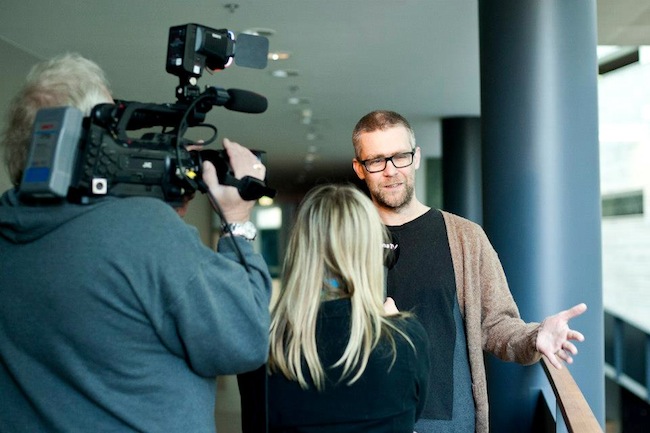
Artist Dénes Farkas during the press conference of Estonia's national pavilion at the 55th Venice Biennale
But do you really think that Wittgenstein's philosophy is relevant now, in the context of today's art? Even Duffy's book was written back in 1987...
Wittgenstein's philosophy is about language and logic. Both of these subjects, in my opinion, will never loose their relevance. If you wish, we can look at it this way – I am the curator for the exposition in Estonia's national pavilion. In the context of Estonia, language is a problematic issue – how to keep your language, and language as the core of national identity. Wittgenstein's most popular quote, which has now become a cliché – “the limits of my language means the limits of my world” – there you have it, identity. Wittgenstein's “Philosophical Investigations” begins with questions about what are words, how did words gain meaning? Whereas Dénes has the maxim, “meaningful meaningfullesness”, or a meaningful “not-knowing” – the need to err. In his art, Dénes absolutely does not show the world as something perfect. The same goes for his methods of working – clumsy cardboard models, as if created by a child – have definitely not been made with the aim of having the viewer believe in them. It's the exact opposite – to not believe, to doubt. But with their charming execution, the works seem even truer. If they were technically perfect, then they would become just beautiful illustrations; they wouldn't invite one to “read on”. That is another parallel that can be drawn between Duffy's method of building historically imprecise characters, and Dénes' execution of his art.
You are a Polish-born curator living in Los Angeles, and are now taking part in representing Estonia. Nationality is increasingly loosing its decisive importance in art. Doesn't this make you feel that the format of the Venice Biennale, i.e., the having of national pavilions, is unjustifiable and outdated?
(Thinks) What is important is that every time the Biennale takes place, the issues of nationality in art are brought up – “Is nationality important or isn't it?”, and so forth. At the same time, of course, comprehension changes, geography changes, and identifying oneself with a certain nation has become vague, or even unimportant, in the art world. It is no longer that important what your mother tongue is, who your parents are, or what the nationality of your spouse is; in place of “born”, they now write “based”, because where you are located right now is the main thing.
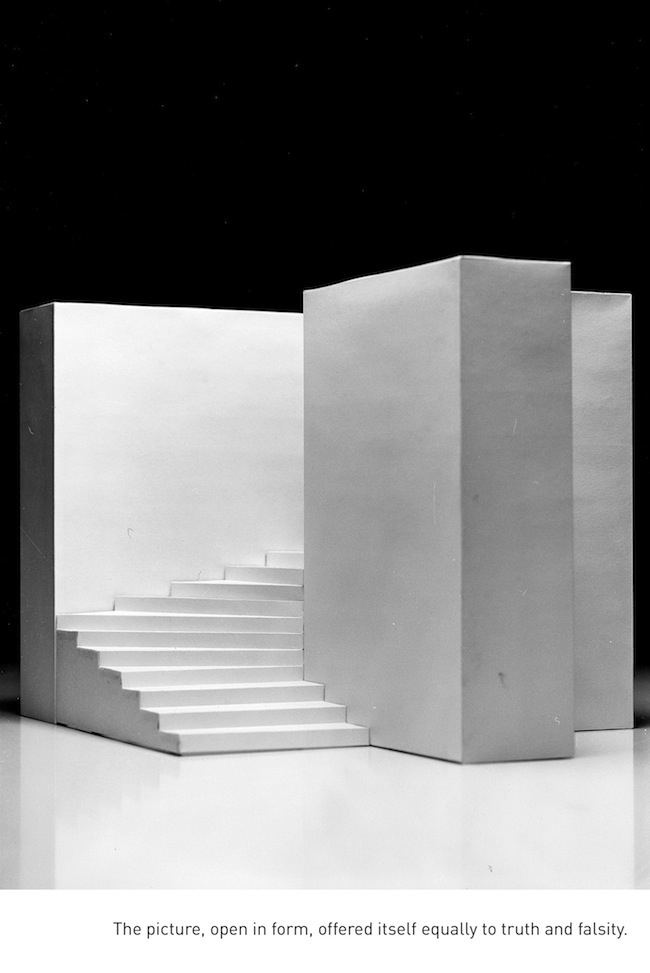
But why then are there still national pavilions?
Take into consideration that the Biennial will be taking place for the 55th time, so the concept of it is more than a century old. In addition, the structure of the pavilions have powerful territorial meaning. The Giardini pavilions are historic buildings; some were erected at the start of the previous century. It is hard to simply let go of something like that. The second oldest biennale is the São Paulo Biennale, which also had the principle of national representation, but they did away with that about ten years ago. It was easier for them because the São Paulo Biennale doesn't have this territorial and historical link – the pavilion buildings – as Venice does. The word GERMANIA is still written on Germany's pavilion. All of the experience of the past is there; it is history. Today, it is important to question nationality, like the same German pavilion did with the British artist, Liam Gillick, in 2009; or this year, when Germany and France will switch places with their exhibitions. Just as Poland's 2011 national exhibition was created by the Israeli citizen, Yaela Bartana. Currently, it is important to accept the concept of the Biennale – the rules of the game – but to not be too attached to nationality, because that is limiting.
You once said in an interview that you like to watch films and read philosophy and literature, because art history on its own seems too narrow a subject. Is this true?
I said that? I don't recall...
Yes; in fact, the interview took place in Riga.
My interests are interdisciplinary, that is true. I am not an art historian by education – I have a degree in theater and I wrote my senior paper on the cinema, and then I studied architectural theory. I don't pay much attention to the discipline of every text that I read; I'm just interested in texts that are sensitive to language, sensitive to words. That's why I love poetry. I am also attracted to vagueness in art – when it's hard to define what the piece belongs to. Situations that rock preconceived notions, that open new rooms, intrigue me and raise questions about my place and role in the world, make me guess at the obscure. While a clean and clear image is just a clean and clear image – that bores me. Maybe I am so enthusiastic because I came to art from a slightly different field; my ignorance is my trump card. Richard Serra once wrote that the whole can be understood much better if you haven't buried yourself in copious investigations and melded together with the concrete situation. You must keep a distance of “not knowing”.
At the same time, the Estonian pavilion's exhibition is specifically based on particular texts. The homepage even has a section called “The Library”, which lists the titles of eleven books. It is knowledge that is required – not ignorance.
I don't think that it is decisively important to know the specific texts. This is more about the translation – if you're not familiar with Wittgenstein's language, then translate what you see in a language that is close to you – maybe look at the world as an architect? The most important thing is the process: that you “read” art, and the way in which you “read” these works of art. Wittgenstein also lived on the borderline. An engineer by education, he made model airplanes and kites – it's fascinating how diverse his interests were, and that he tried to express himself in so many different languages!His saturated personality definitely inspires our team. He was, however, a very impatient teacher, and was sacked for hitting a student who then fell unconscious – the student had answered incorrectly.
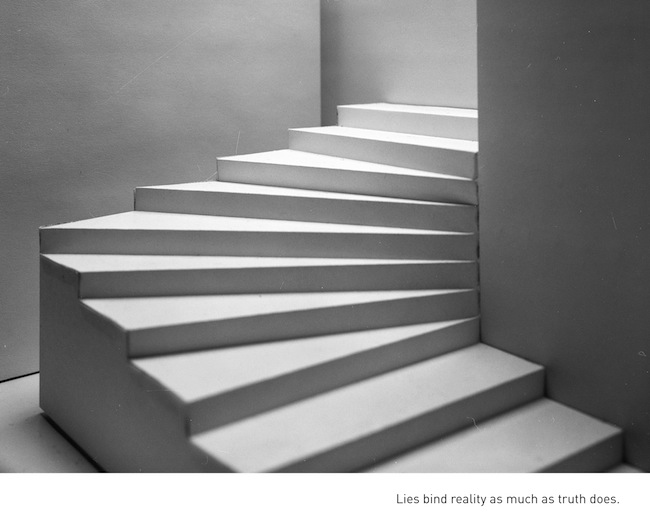
I take it that this short-temperedness doesn't apply to your team... The process sounds really exciting – the coming together of a curator, a philosopher, a linguist, an architect, and a writer. Yet what is the role of the artist here?
Dénes Farkas' job is to summarize our contribution and to integrate it into the exhibition – to put it together. I wouldn't want to call it a hierarchy; it could be better illustrated with astronomy, in which Dénes is a planet, but the rest of us are like satellites that orbit around him and send him signals. Dénes embodies an unknown destination, because he has the last word.
“The Library” on the homepage lists not only the central texts (books by Bruce Duffy and Wittgenstein), but also many others. Alain Robbe-Grillet's “Jealousy” caught my attention. Being a writer, he was, nevertheless, close to the art world, especially to painters, even though architecture has great importance in his works. But tell me, how will “Jealousy” be used in the exhibition?
Just as inspiration, a reference, because essentially, the story is about the same thing. When you open the book, “Jealousy”, the first page is a layout of a house. The first paragraphs are devoted to describing how the sunlight and shadows glide through the rooms. The text serves as inspiration for Dénes, so that he could see one more example of a relationship between a reader and the process of reading. If in Duffy's book it was the inhabiting of a character, then in Alain Robbe-Grille's “Jealousy”, the reader inhabits a space, a house. After all, the reader resides in the text; for some period of time, he resides there permanently. By the way, if you could only see Dénes' copy of Duffy's book – he has practically physically inhabited it. First of all, he bought an older issue on eBay – one that already had a history. It has underlined sentences, notes, folded-down corners – the book looks like an autopsy, but at the same time, it's fantastically beautiful.
I'm guessing you're going to exhibit it?
Yes, I'm thinking exactly about doing that.
Have you noticed the curating trend of the last few years, in which exhibitions are organized much like Renaissance-era “cabinets of curiosities”? Examples being Massimiliano Gioni's concept for the Arsenal exhibition, “The Encyclopedic Palace”, which has already been called “image anthropology”; and at dOCUMENTA(13), in which curator Carolyn Christov-Bakargiev (unsuccessfully) tried to exhibit a meteorite alongside contemporary art. It is not quite interdisciplinary-ism anymore that is marching under the “flag of art”, but rather, pure science, history and archeology. What does this mean? What does this forecast? What can we expect?
I allow that this could be due to a growing interest in human creativity, as such. Maybe the notion of art that has been classified as “high art” has become dull – one-sided. And that's why there's a search going on beyond the borders of art. Take, for instance, the source of inspiration for Gioni's concept – the autodidact, Marino Auriti. At the beginning of March, the Philadelphia Museum of Art opened a huge exhibition called “Outsider Art”.It includes the almost completely deaf, American autodidact from the early 20th century, James Castle; although I wouldn't call him an artist, but rather an outsider, Gioni has also included Castle in Venice's main exhibition. I should also mention Rosemarie Trockel's big exhibition, “A Cosmos”, which has now come to the Serpentine Gallery in London, via New York's The New Museum. The German artist, Trockel, has placed various scientific objects and images, such as from botany and biology, alongside her works. In my opinion, this all reverberates with the concept behind Austria's Universalmuseum Joanneum. The Graz Art Museum, at which I worked for nine years, also belongs to this “universal” museum association, alongside museums of natural history, history, zoology and archeology.
But why is this trend showing up in art exhibitions?
Art is the most contemporary of forms of human creative expression. Sort of like a final destination, where all of the other influences and inspirations meet, mix and cooperate, creating one, unified “picture”. In contemporary art, in my opinion, one can observe growing interest in a sort of “archeology of knowledge”. Artists are heading considerably beyond the borders of art, and are doing practically scientific studies. Why is that? Maybe the distancing from formalism is growing. After all, what is art about? It is looking out of the window – at the neighboring houses. That's exactly why I like to work with Dénes – because he provokes me to look out of this window, and to go beyond the “artistic”.
The house of Wittgenstein's sister, in Vienna – Wittgenstein took an active part in designing it.
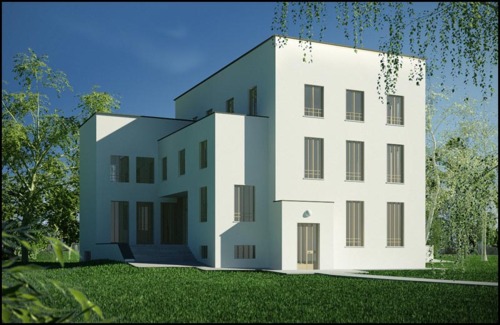
A house in Vienna, which was co-designed by Ludwig Wittgenstein
The doors and windows were the main things in which Wittgenstein took an interest, I'd say – even an exaggerated interest, when participating in designing his sister's house in Vienna.
Yes, he worked pedantically with details as well. The house was de-ornamentalized. Wittgenstein was so strict and precise that it took him one whole year to design the doorknobs, and another year for the radiators. By the way, I was just in Vienna. (Shows pictures that he took of Wittgenstein's house on his iPhone.) Clean geometry, incredibly tall doors, but as narrow as a thin woman. It's fantastic! Isn't it an interesting coincidence that the house that Wittgenstein designed is so similar to Dénes' models? (Takes out from his leather briefcase a book on Wittgenstein.) I'll just show you something, see here (points to a page with three different house plans) – look how he's written by each one: “This doesn't work; This still doesn't work; This works only, if it fails.” In my opinion, this is the manifesto of Dénes Farkas' art. We will definitely print this!
How does Dénes Farkas feel, having discovered such a connect to Wittgenstein, when he had never even heard about him before then? It must be nice.
It is the same as discovering in the texts an artist who thinks like you. My overall view is that our lives are a series of identifications. These are those fairytale moments when you arrive on the same plane as the world. I really want the exhibition to have the aura of Wittgenstein's house, but not in a literal sense.
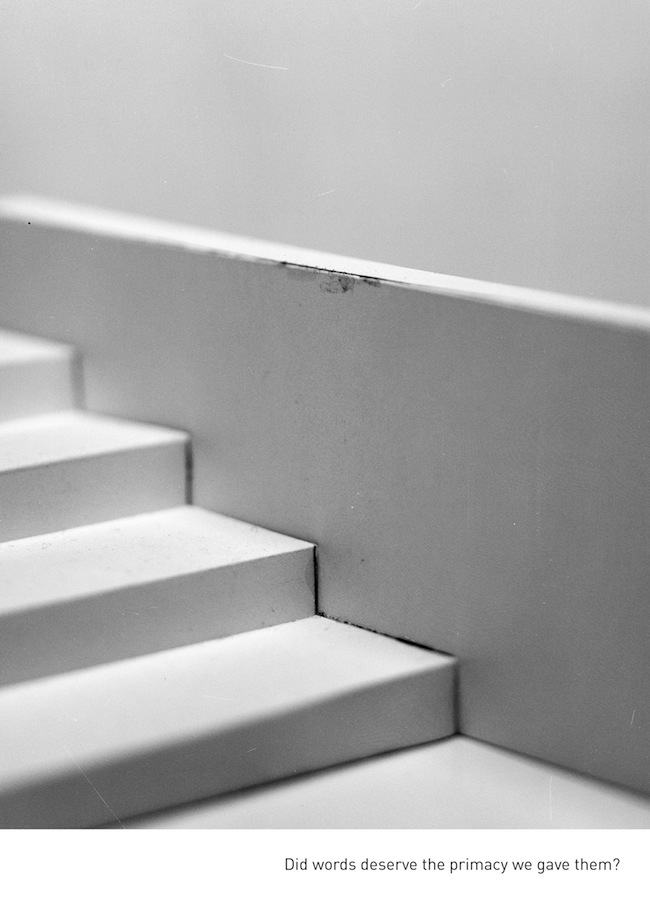
There's a rumor that Wittgenstein's sister could no longer afford all of the pedantic accuracies that her brother had introduced during the building of the house. Once the house was finished, he still wanted to the raise the ceilings by 30 millimeters... Wittgenstein then supposedly bought a lottery ticket, hoping he might win... How's it going with the budget for Estonia's pavilion?
Money is, of course, a problematic issue; especially in working with the London-based graphic design office, Zak Group, which is world-famous. It's the same with Markus Miessen, and we also have to pay all of the writers of the essays in the exhibition's book. We get a “friend rate” because we know each other well; that was the only way it was possible. Personally, I haven't received a penny for almost a year now, but the budget for bringing the exhibition to execution is 10 thousand euros.
Actually, we've already planned to rob a bank...
Where? In Estonia?
I can't reveal that!